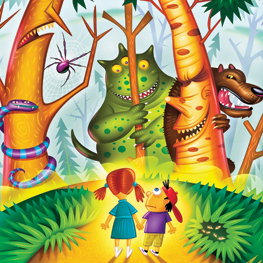
Bad news for parents of school-age kids: the early school years are a prime time for nightmares. For many children, nightmares peak between the ages of five and eight, thanks to an increasingly active imagination, fantasy play and newly acquired social awareness.
Nightmares are a near-universal childhood experience, and up to half of young children experience recurring nightmares at some point. That’s not necessarily a bad thing, according to clinical psychologist Matt Woolley, Ph.D.; nightmares may serve a developmental role. “Parents want to rid their child of nightmares entirely,” he says. “But that’s not necessarily possible or desirable. Occasional nightmares are a normal experience.”
While nightmares are normal, some children seem to get more than their share, and their sleep can suffer as a result. Kids who experience excessive nightmares (more than two per week) can become sleep-avoidant, sullen, irritable and show signs of depression.
Thankfully, experts say that some nightmares can be prevented or minimized. Parents can pave the way for sweeter dreams by learning about the top ‘nightmare triggers’: events or situations likely to bring on bad dreams. Nightmare triggers run the gamut from social (adjusting to a new school) to physical (having a high fever) to experiential (riding a roller coaster for the first time), and they may surprise you.
Tricky transitions
Starting a new school or daycare, beginning a new class or sport or being away from a parent or other caregiver can contribute to a child feeling temporarily helpless. These feelings can bring on nightmares, says Woolley. “When children have a lot of nightmares, it’s not uncommon that there are a lot of changes going on at home,” he says.
How to help: Discuss life transitions with your child, preferably in advance. Encourage your child to talk about things that may be bothering them.
Dream danger
Scary or unsettling experiences like car accidents, injuries or other real-life traumas can be nightmare fodder for children. The death of a relative or pet or a divorce in the family can also cause emotional distress that plays out in the form of bad dreams.
How to help: After scary or traumatic experiences, encourage creative expression in the form of journaling or drawing. Art and creative play can help children communicate and process troubling emotions, says Woolley.
Rated N for ‘Nightmare’
Media research firm Nielsen reports that elementary-school-age children watch 28 hours of television per week. All of those hours clocked in front of the boob tube can contribute to nightmares, especially if kids watch intense or troubling content. “The central themes of many children’s stories - separation from or loss of parents and friends, or evil people hurting innocent ones - are very commonly upsetting,” says Jan Drucker, Ph.D.
How to help: Don’t allow your child to view troubling, intense scenes on television, particularly before bedtime.
Under pressure
Music or dance recitals, tests at school and sports games can bring on excitement, worry - and nightmares. Dreams are often an opportunity to relieve pressures of the day, says Drucker. When there are big demands placed on a child, dreams become a time to replay anxiety or stress over the event.
How to help: Any time your child is facing a transition, special challenge or new experience, stick to an earlier bedtime and spend extra time winding down and relaxing before bed.
New places, new faces
A trip on the amusement park ride; a long-awaited airplane trip; a longed-for visit with faraway cousins - new experiences, even enjoyable ones, can trigger nightmares. “The first time a child does something, it’s nearly always stressful,” says Woolley. “The brain reprocesses that stress at night in the form of a nightmare.”
How to help: Limit new-experience stress by following an exciting ‘first’ with a familiar, comforting activity - after a child’s first roller-coaster ride, wind down with a leisurely walk or relaxing tunes.
Late-bedtime boogeyman
When kids stay up too late, nightmares can come calling. That’s because sleep deprivation results in the fitful, poor quality sleep that can trigger bad dreams.
How to help: Ensure that your child gets enough sleep - most children aged five to eight need between 9 and 11 hours per night.
Pills and chills
Parents are often surprised to learn that medications intended to improve their child’s health can have a detrimental effect on sleep. Mood-altering medications, including anti-depressants and medications for ADHD, can negatively impact sleep or trigger nightmares, particularly when taken over a long period of time.
How to help: Talk to your doctor about any medications your child takes and ask how you can minimize any negative effects on sleep.
Discomfort drama
When kids toss and turn because of a too-hot bedroom, ill-fitting PJs or an old, saggy mattress, bad dreams are more likely to happen, says Woolley. Fortunately, the most common discomfort-related nightmare trigger - sleeping too hot - is easily remedied by removing a child’s socks, switching to lighter-weight pajamas or removing a heavy blanket.
How to help: Keep the bedroom quiet, dark and cool - between 15-and-a-half to 20 degrees is ideal. During warmer months, switch to lighter-weight pajamas and remove heavy blankets.
If your child has more than two nightmares a week for over a month, a visit to a doctor or psychologist is in order. And take heart: like teddy bears and footie pajamas, bad dreams are often a passing childhood phase. In the meantime, healthy sleep habits mean sweeter dreams, fewer nightmares and happier mornings.
Malia is a freelance writer and mom of two who specializes in children’s sleep and health topics.
Calgary’s Child Magazine © 2024 Calgary’s Child